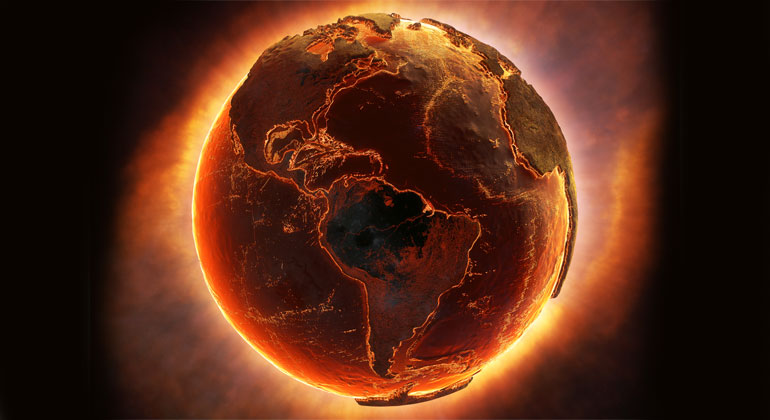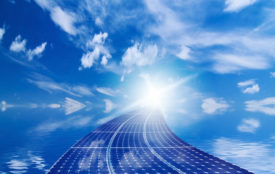Power of the sun
Towards much-needed energy. In a few decades the industrial countries have consumed as much coal, gas and oil as nature has accumulated in 300 million years.
We face an unavoidable necessity to plot a course for a one hundred per cent shift to renewable energies in the coming decades. The energy sources gas, oil, coal and uranium to drive the nuclear power stations will run out in the coming decades. There is no doubt also that in the 20th century the global climate has warmed by 0.8 degree already!
Climate research suggests that a global warming of up to 8 degrees in the next 100 years would not be sustainable, with reference to the thawing permafrost in Siberia which would release billions of tons of methane. One methane molecule destroys the climate 22 times more than one carbon dioxide (CO2) molecule, which has been the primary focus of the scientists. Millions of cattle worldwide release additional methane. Therefore, the rising consumption of meat is also a climate problem. The decline in affluence seems unavoidable, unless the world community comes up with a new, soft energy path. It is not too late – we have one more escape route from the greenhouse.
According to scientists, if, as forthcoming, CO2 emissions pour from 2.5 billion car exhausts (there are presently about 800 million cars on the road), more power stations produce even more billions of tons carbon dioxide worldwide, hundreds of millions of houses are heated by oil and gas, and every hour more than a thousand hectare of rain forest is torched to make way for soya cultivation and palm-oil plantations, then the planet is beyond saving. For like the roof in a greenhouse, the CO2 released during burning and methane and other climate killers wrap themselves around the earth.
The result is that because of the greenhouse-roof effect the sun’s heat radiant on earth does not flow back into the atmosphere. The planet starts to sweat like it is in a greenhouse. The temperatures climb. The climate disaster is here – already today. And even more so tomorrow and beyond. We are burning the future of our children and grandchildren, not behaving like people who accept responsibility for future generations.
The signs of climate disaster
The portents of climate disaster are unquestionably evident today:
- ground water levels dropping
- forests shrinking worldwide
- deserts spreading • pasture lands contracting
- soil erosion • species dying out and
- daily population increase of a quarter million people.
Today, the wealthy owners of 800 million motorcars compete for the same food resources with 1.2 billion poor people who have to live on less than a dollar a day and have no access to electricity. Should corn be grown henceforth in Mexico as an inexpensive food for the poor or as biofuel for millions of cars of rich Americans? Bioenergy for US tanks or food for the plates?
There will be not only a competition between food and biofuel, but also a conflict between food production and water supply. The three largest grain producers in the world – USA, China and India – have for a long time been overtaxing their water resources and are struggling with declining groundwater levels. To produce one kilogram of meat requires 10,000 litres of water.
The poor are most affected
Half the world’s population lives in the three countries and in other societies whose groundwater levels are dropping rapidly. In China there are 1.3 billion people, in India 1.1 billon, in USA 300 million, in Indonesia 240 million, in Pakistan 150 million, in Bangladesh 144 million, in Mexico 110 million, in Iran 72 million, in South Korea 48 million and in Spain 44 million. In all the countries where the water table is falling rapidly there threatens the end of conventional agriculture, suggesting unimaginable famines.
More than 600 years ago the inhabitants of Iceland had to realise that the overgrazing of their green highlands led to massive soil erosion. To regain the grassland, the Icelandic farmers laid down firm quotas, including rules limiting their sheep numbers to ecologically sustainable levels. The Icelanders have survived, but the Mayas and the Sumerians became extinct for ecological reasons.
Climate protection or destruction?
More than 2,000 climate scientists have presented on behalf of the UN several detailed and alarming reports about what could be in store for us through the climate change:
- only one degree warming in the 21st century and 80 per cent of the coral reefs will permanently suffer from bleaching and die off. The disappearance of Andean glaciers threatens the water supply of 500 million people.
- two degrees of global warming depletes Africa and the Mediterranean region of up to 30 per cent less water. 30 per cent of all animal and plant species could be wiped out. In Africa 60 million people will suffer from malaria.
- three degrees of warming exposes Southern Europe to droughts, famine and water shortages. Up to 170 million become flood victims – a third more people than today must starve.
- a four-degree warming will translate into 300 million dead in coastal areas worldwide.
- And with five degrees of warming fish and fishing in the oceans and all life forms are endangered. Half the human population suffers from water shortage. The Himalayan glaciers melt, meaning the five largest rivers in Asia suffer an extreme shortage of water. World cities like New York, Tokyo, Lisbon, Cairo, Bombay, Shanghai and Chittagong are threatened in their existence.
Energy turnaround is possible – The solar age is here
The solution to the energy problem is in the sky. The sun sends us every second 15,000 times more energy than all seven billion people currently consume. Seen from nature, there is naturally no energy problem. There are also the sister technologies: wind, hydro, bioenergy, wave and ocean energy, geothermal energy. With continued growth of solar power, a kilowatt hour of solar energy is becoming as cheap to produce as the cost of nuclear or brown coal from the socket outlet. The difference is that solar energy production produces no waste. And the sun does not send us a bill! Solar energy is – like wind power – a present from the heavens. Through mass production the technology is becoming better value all the time. Italy and Spain have also achieved ‘grid parity’, that is, the approximation of the prices of solar power and conventional electricity. There will soon be no more place for coal and nuclear power stations.
Renewable electricity can be stored
Instead of fossil or nuclear power plants, more flexible solutions are required. When a lot of electricity is produced but little used, water storage can be filled up and, if needed, can be used for short boosts of additional current production. The Netherlands has developed large water storage potentials in Norway by way of a submarine cable. The fossil fuels currently often block the storage capacities of the green energies. In the future the old sources of energy should depend on the environmentfriendly sun and wind capacity on offer – and not vice versa. It is true that we have storage problems when switching to solar energy, but what is also true is that these problems can be solved.
The problems of the fossil fuels – such as their finite nature, the environmental destruction or the unsolved question of nuclear waste disposal – are, however, fundamentally unsolvable. The storage problems can be solved by a mix of renewable energy sources. We can, for example, combine wind turbines at sea with wind turbines on land – there is always wind somewhere. Interesting also is the combination of wind and sun. When the sun is not shining, wind is often blowing, and when there is no wind, the sun is often shining. A part of the infrastructure for the change to solar energy lies in the fact thar we can turn millions of buildings into millions of solar power stations. The sun shines onto every roof. Energy will in future be produced where it is needed.
Bioenergy and geothermal energy can be stored without problems. Electric cars will also have an important function with storage of solar and wind power overnight in the future, likewise solar-produced hydrogen.
A future with renewable energies means innovation.
Source
Franz Alt 2013 | Translation: Werner Huemer 2013 | GRALSWELT 2013








